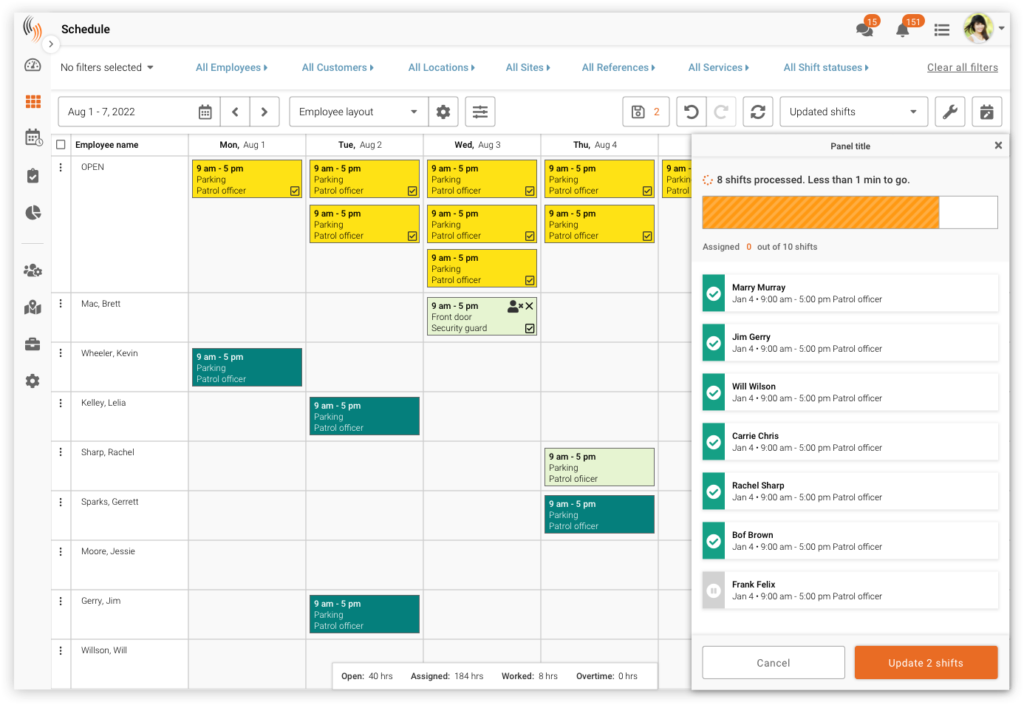What is Shift Management?

Shift management is the process of arranging various types of employee shifts and assisting with their association and avoiding complexity. Shift management tools are very important in allocating and optimizing resources and teams. It guarantees that the right mix of staff and managers are working on a certain role. This makes sure that the best quality of work is being given to the specific job being carried out. Planning out employee shifts is utilized intensely in different industry verticals like security, healthcare, hospitality, and manufacturing where overseeing shifts of employees is a pivotal process.
With Shift Management, either HR can schedule shifts of an employee for an entire month or they can just change the generally scheduled shift to another time for a solitary day. This streamlines the shift management process to HR managers and makes the planning a lot easier.
Challenges of shift management
Unexpected worker Absences
Managers need to factor in sudden changes to their roster schedule. This can either be due to a change in business demand or due to workers dropping out of schedules. The change needs to be manually logged and re-communicated back to relevant workers and on-ground supervisors. This often results in missed information and no-shows.
Inability to schedule shifts at scale for a larger workforce
Managing any workforce is a challenge. When managing hundreds of workers across different locations and positions, scheduling is a challenge of its own. There is a lot of data to be recorded and a lot of moving parts causing a high potential of data entry errors.
Ineffective communication channels

Many managers or supervisors currently use two different platforms to create shifts and notify workers. The commonplace practice we have observed is to schedule shifts on Excel spreadsheets firstly. Then a picture of the sheet is taken and a printed copy is sent to workers via Whatsapp groups or posted on a notice board.
Communication via group chat is hard to control and is often filled with irrelevant messages from other workers. This causes employees to miss out on the most important schedule updates.
Loss in workforce productivity due to no-shows and churn
When workers do not show up to work, businesses can miss productivity targets for that day. But the issue extends even further. Deloitte found that employees are 174% more likely to churn if there is a lack of effective real-time shift scheduling processes.
Keeping your workforce in sync when it comes to shift scheduling is an essential part of managing job satisfaction. If workers frequently show up to the wrong shifts causing them to earn less income, they are nearly twice more likely to churn and find other employment.
Disintegrated systems and error-prone data
Manual systems are susceptible to both intentional and unintentional error. Data mismatch in shift schedules can create confusion. Employees can be mislead regarding when staff are expected to come, resulting in shift no-shows, inaccurate attendance tracking and paying the wrong amount to workers.
Disintegrated spreadsheets and systems may result in errors in data reporting. This causes schedule miscommunication or errors in attendance and payroll reporting. Attendance report errors need to be reconciled. This may take up a lot of time and may impact the accuracy or timeliness of worker payments and job satisfaction levels.
How to simplify Shift Work
When it comes to understanding labor laws and preparing your business, the unsung hero is software. The right software can automate schedules and make them more efficient and less time-consuming for employers. This helps them ensure accurate headcount based on demand, leads to far fewer schedule changes, and thus happier employees.

Here are some of the common features of Employee Scheduling software that make shift management easier;
- Real time text & video messaging features, including conducting visual walkthroughs of new procedures.
- Scaled pay, which automates different pay rates to the same employee according to the job they are fulfilling as well as location they are in.
- Mobile apps allowing employees clock in and out of work, as well as start and end breaks with the touch of a button on their phone.
- Tailored schedules that are generated based on employee preferences (e.g. shift length, days, locations, and availability).
How Celayix Simplifies Shift Management
Celayix is a best of breed tool that allows companies to seamlessly create and alter shifts. Through our efficient scheduling platform, managers can save on time and effort and focus on more pressing issues related to the company.
Choosing the correct Employee
Through the Celayix Scheduling platform, managers can roster their employees monthly, weekly or daily. All employees on the platform can have specific attributes which demonstrate their experience and competencies. This allows managers to choose employees who are best suited for the job at hand.
Celayix Scheduler is a simple and user-friendly scheduling solution that can be tailored to all of your business rules and allows the scheduler to control whether the rules will be followed or relaxed for specific scheduling situations. Some of the rules supported include:
- Overtime rules based on number of days and/or hours worked
- Defining weekday/weekend overtime rules
- Union / collective bargaining rules specifically outlining how employees will be assigned to shifts
- Ensuring only qualified and available staff are scheduled
- Age restrictions on certain shifts
This mitigates unqualified employees from being scheduled to doing a job that they are incapable of doing.

Employee Self-scheduling
Through the Celayix Mobile App, employees are given the autonomy of selecting their own shifts. Managers can send out available shifts over a period of time and employees can choose the shifts they like, taking responsibility away from them.
Celayix’ self-scheduling is also managed by the Celayix rules engine, which ensures that only those employees who meet ALL of your shift criteria will see the shift available for self-scheduling.
Artificial Intelligence (AI)
When Celayix talks about Artificial Intelligence, we are talking about using state-of-the-art Machine Learning technologies to look at past employee schedule performance and make decisions on which employees are better suited for a new shift schedule.
In addition to Celayix’ Rules Engine, Auto Fill, and Find Replacement features, the Celayix AI Recommendations feature will use your past schedule performance to recommend the best fit employees for your new schedule.
Find a Replacement
Celayix Scheduler’s Find Replacement feature allows you to respond quickly to unexpected shift drops, no-shows, sick-calls, and other emergencies. Instead of being frustrated with these situations, you can see a list of available and qualified replacements, and either reassign immediately to your preferred choice, or send a request out via the Celayix Mobile app to schedule the first or best responder.
Now you can let go of the stress of managing unexpected events.
Autofill

To further automate the shift assignment process, schedulers can use the Celayix exclusive Autofill feature.
Autofill works as the name implies. Once the shifts have been created and entered into the schedule (or inserted via a shift template), autofill can be run to fill the shifts. Essentially this is a set-and-forget strategy or more likely a “set and go do other tasks” approach. This approach can save the scheduler a significant amount of time as they do not need to fill each shift themselves. Rather, they can let the system automate the assignment process.
When it comes to simplifying the shift management process, Celayix provides the tools you need to succeed. The shift management process can pose many problems if not managed correctly. Software is the key to saving time and money in this area and also makes HR and Ops managers more efficient in their work. With fewer mistakes made and employees more satisfied due a clear and easy to use platform, businesses can seamlessly manage their employees’ shifts and focus on the more pressing issues on their agenda.





